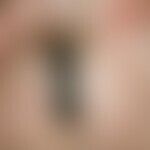Synonym(s)
DefinitionThis section has been translated automatically.
Location-specific growth type of malignant melanoma growing on the palms of the hands and soles of the feet, fingers, toes and under the nails. Acral lentiginous malignant melanoma grows flat horizontally for a long time, often unnoticed or misrecognized, before it becomes recognizable as a tumor nodule by a vertical change in growth. Not infrequently, advanced melanoma of the acrolentine type lacks the "signal color black" so that the node can appear "inconspicuous" reddish or yellow-reddish. This is especially true for ulcerated acrolentiginous melanomas.
Occurrence/EpidemiologyThis section has been translated automatically.
ALM accounts for about 4-5% of the total melanoma incidence, and subungual ALM for 1-3%. From this, incidence rates between 0.2-0.3/100,000 inhabitants can be calculated.
You might also be interested in
EtiopathogenesisThis section has been translated automatically.
Among acrolentiginous melanomas, the subungual/interdigital group is the most diversified, with oncogenic mutations in the PIK3CA, STK11, EGFR, FGFR3 and PTPN11 genes. They are less likely to have BRAF mutations and show a higher frequency of copy variations (67%!) especially in CDK4 and cyclin-D1. (Haugh et al. 2018)
ManifestationThis section has been translated automatically.
Elderly people > 60 years. No gender specificity!
ClinicThis section has been translated automatically.
Differently large, brown to black, blotchy or plaque-like skin changes.
Horizontal-radial, later circumscribed or diffuse vertical growth with infiltration of the dermis and increasing contouring, nodular, scaly elevations. Superficial erosions, ulcerations.
The clinical maximum variant is a weeping, bleeding tumour node surrounded by a thickened corneal layer.
Other ALM grow for years in a horizontal direction, remain clinically as flat plaques, almost at the skin level, usually with regressions, so that anular or circulatory structures can develop which no longer have structural commonality with the primary image. Complete regressions are also possible.
- The subungual malignant melanoma shows an independent clinical morphology. Although it is a subtype of acrolentiginous malignant melanoma, it is treated independently and as a subungual malignant melanoma.
- Reflected light microscopy: Initially striped, irregular pigmentation, orienting along the inguinal lines, brown, blurred spots in the tumor surroundings.
HistologyThis section has been translated automatically.
TherapyThis section has been translated automatically.
Progression/forecastThis section has been translated automatically.
The prognostic indicators are by far not as precisely determinable as in malignant melanomas of other localizations, since the Breslow index in acral localized melanomas often conveys imprecise values or cannot be assessed at all.
In follow-up studies of metastatic thin melanomas (tumor thickness < 0.75 mm s. Breslow index), the ALM and LMM were significantly overrepresented.
Acral lentiginous melanomas tend to have superficial horizontal growth initially and for long periods. As they are often clinically diagnosed late, they are frequently diagnosed and treated at an advanced stage.
The expression of c-Kit plays an important role in the therapy of metastatic acrolentiginous melanoma (see imatinib below).
LiteratureThis section has been translated automatically.
Baccard M et al (2009) Acrolentiginous melanoma. Ann Dermatol Venereol 136:389-390
Baumert J et al (2009) Time trends in tumour thickness vary in subgroups: analysis of 6475 patients by age, tumour site and melanoma subtype. Melanoma Res 19:24-30
- Fallowfield ME et al (1994) Melanocytic lesions of the palm and sole. Histopathology 24: 463-467
- Gutman M et al (1985) Acral (volar-subungual) melanoma. Br J Surg 72: 610-613
- Haugh AM et al (2018) Distinct Patterns of Acral Melanoma Based on Site and Relative Sun Exposure.
J Invest Dermatol 138:384-393. - Margolis RJ et al (1989) Comparison of acral nevomelanocytic proliferations in Japanese and whites. J Invest Dermatol. 92(5 Suppl): S222-226
- Mishima Y, Nakanishi T (1985) Acral lentiginous melanoma and its precursor-heterogeneity of palmo-plantar melanomas. Pathology 17: 258-265
- Schmidt-Wendtner et al (2003) Disease progression in patients with cutaneous melanomas (tumor thickness < 0.75 mm): clinical and epidemiological data from the tumor center Munich 1977-1998 Br J Dermatol 149: 788-793
Schoenewolf NL et al (2012) Sinonasal, genital and acrolentiginous melanomas show distinct characteristics of KIT expression and mutations. Eur J Cancer 48:1842-1852
- Shaw JH, Koea JB (1988) Acral (volar-subungual) melanoma in Auckland, New Zealand. Br J Surg 75: 69-72
- Tuominen L, Strengell L (1992) Melanoma of palms, soles, and nail-beds. Scand J Plast Reconstr Surg Hand Surg 26: 287-292
Incoming links (10)
Acral lentiginous melanoma; Alm; Fgf; Nail organ; Onychodystrophy (overview); Pik3ca Gene; Plantar/palmar melanoma; Ptpn11 gene; Subungual melanoma; Tyrosine kinase inhibitors;Outgoing links (13)
Abcd rule; Breslow index; Cycline D1; Egfr gene; Fgf; Imatinib; KIT gene; Melanoma cutaneous; Pik3ca Gene; Ptpn11 gene; ... Show allDisclaimer
Please ask your physician for a reliable diagnosis. This website is only meant as a reference.



















































